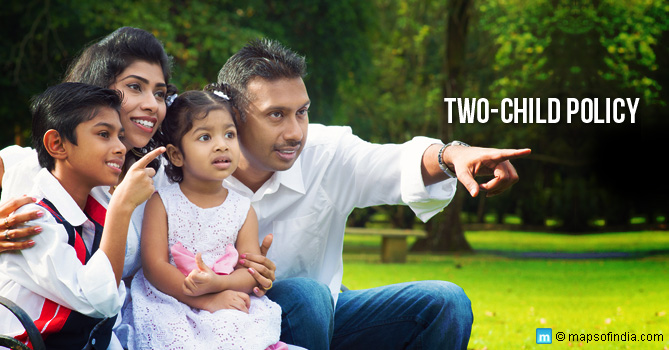India was one of the first countries to introduce a population control plan way back in 1952, but despite several family planning initiatives, incentives and schemes, population has now grown close to 1.3 billion. By 2028, India is expected to overtake China to become the most populous country in the world. That’s a serious concern for a country that’s trying hard to improve the quality of life of its people.
Population facts
As per Census 2011, India’s population stood at 1210.2 million, which is a 17.7% increase over 1028.70 million in 2001. The 17.7% rate of increase in population in the decade 2001-11 is lower than 21.5% increase witnessed the decade before.
Therefore, the pace of increase in population is actually declining between decades. 181.96 million people were added between 2001 and 2011, while the sex ratio of the population stands at 943. The per square km density has been increasing, especially in urban areas and currently stands at 382 persons per km, putting tremendous pressure on its limited natural resources.
Family Planning and India’s two-child policy
It is impressive that the government just after independence was apprised of the fact that the country needed to control population growth and set up the Family Planning Association of India in 1949. The government initially focused on birth control but soon expanded its purview to include women and children’s welfare, health and nutrition.
The two-child policy was adopted and people were encouraged through various government benefits and incentives to restrict the family size to four, including two children. However, success achieved during different periods since early 50s has been widely debated, with most experts holding the opinion that family planning measures as planned by the government failed to check the growth in population.
During Emergency from 1975 to 77, the ruling Congress party came under heavy criticism for its high-handed and often coercive methods of family planning and birth control measure that were forcefully enforced. The people reacted by voting the Congress party out in 1977.
Various governments since then have tried to incentivize and educate people on the need and benefits of family planning but continued with promoting its two-child policy.
Has the two-child policy worked?
If one were to compare growth rates between 1991-2001 and 2001-2011, the rate of population growth in percentage terms actually declined from 21.5% seen during the 90s to 17.7% seen during 2001-11. Today, India has the largest pool of young population in the world and this is an asset for the nation if harnessed productively.
So broadly, the two-child policy seems to be working in India’s favour but is it enough, given the fact that economic development and agricultural growth has not grown proportionately to sustain this substantial increase in population?
Moreover, two-child policy has had varied responses from different sections of people. In urban areas, there has been greater acceptance of the two-child policy whereas in rural areas, it has not been widely practiced.
The reason for this is mostly economic but also due to the fact that infant mortality is higher amongst the poorer sections that reside mostly in rural areas. Amongst the economically weaker sections, more children mean additional hands to support the parents in the fields or at home. Whereas, in urban areas, lack of space and high cost of living is forcing people to restrict the family size to four.
Among tribal communities that largely live off the land, basic subsistence is not impacted with additional children and therefore, government-driven family planning is not really welcomed or adopted among these communities. It is common to see most families in tribal communities bearing more than two children even today.
India’s two-child policy versus China’s one-child policy
Both countries have been facing the challenge of a rapidly growing population but have taken different approaches to tackle the problem.
Communist China under the leadership of Chairman Mao Zedong believed that people were an asset in nation building and encouraged the population to have more babies. As a result, from the time of communist takeover in 1949, China’s population grew rapidly, outpacing India’s. It was only in 1978 that China officially began to recognize the perils of uncontrolled birth and soon introduced the one-child policy.
This was a mandate that covered around 53% of the population but excluded some minority groups. There was strong resentment against the government interfering in people’s personal life and choices but they had no option but to comply. The fall out was that additional children had to be given away and raised by other family members or childless couples thus causing unforeseen social problems.
The long-term effect of one-child policy has resulted in China having one of the largest aging populations in the world today and has also resulted in a huge demographic imbalance. The male-female ratio has widened with males finding it increasing difficult to find a suitable female partner.
India, on the other hand, had adopted policies that were more voluntary and largely encouraged through self-imposed birth control measures, which was supported by cash and other incentives. Barring a brief period during emergency, India’s family planning policies have not generated too much of public resentment.
The long-term impact can be seen in the fact that the rate of growth is slowing down and India today has one of the largest pools of young population, which will be able to accelerate India’s development, going forward.
Should India continue with its two-child policy?
It seems so in the absence of better alternatives. The success of family planning depends largely on people realizing the futility of having more children rather than the government telling them what is right for them.
The right to reproduce is and must remain a personal choice but the prerogative and responsibility to educate and build awareness of birth control and family planning must continue to lie with the government and related stakeholders like NGOs etc.
Political interference in this sensitive space needs to be discouraged. Recent statements like the one from BJP leader Giriraj Singh saying that all communities must be mandated to have only two children and the same was needed to protect Hindu girls from the Muslim community. Statements such as these only act to polarize communities and discourage the two-child policy from being voluntarily adopted.
The need for a small family as an efficient and positively contributing unit must be taught right from school along with the consequences of unbridled population growth. The world over, education and awareness right from school onwards has had more positive impact than any other coercive measures on part of governments.
India must therefore continue to include all sections of societies, in both urban and rural areas, and ensure that education and awareness programmes are well publicized, funded and incentivized to restrict the family unit to four.
Hopefully, in coming years, India will be able to restrict the population growth and optimize its resources for the benefit of its people. The two-child policy will help us achieve that at some point.






